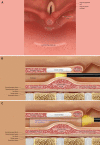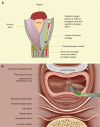Tight near-total corrosive strictures of the proximal esophagus with concomitant involvement of the hypopharynx: Flexible endoscopic management using a novel technique
- PMID: 30487947
- PMCID: PMC6247097
- DOI: 10.4253/wjge.v10.i11.367
Tight near-total corrosive strictures of the proximal esophagus with concomitant involvement of the hypopharynx: Flexible endoscopic management using a novel technique
Abstract
Aim: To investigate the role of a novel minimally invasive endoscopic technique in the management of tight near-total corrosive strictures of the proximal esophagus involving the hypopharynx.
Methods: Two patients with near-total corrosive strictures of the proximal esophagus involving the hypopharynx were managed with the novel endoscopic technique. The technique involved passing a 0.025-inch flexible guide-wire across the stricture, and stricture dilatation, using 10F coaxial diathermy and balloon dilators, followed by electro-incision of the proximal aspect of the residual eccentric stricture by means of a novel approach using a wire-guided sphincterotome.
Results: Both patients were successfully managed on an outpatient department basis with the complete relief of symptoms and resolution of strictures on endoscopy and an esophagogram. No adverse events were seen during or after the procedure. There was no recurrence of symptoms at a follow-up of over a year in both cases. There was a significant improvement in the body mass index of both patients after the procedure.
Conclusion: We report a novel flexible endoscopic technique for the management of complex hypopharyngo-esophageal strictures. In experienced hands, the procedure is relatively simple, safe and effective with a durable response.
Keywords: Benign esophageal strictures; Corrosive injury; Cricopharyngeal strictures; Electroincision; Stricture dilatation.
Conflict of interest statement
Conflict-of-interest statement: We, all authors, declare no conflict of interest relevant to this work.
Figures






Similar articles
-
Benign esophageal strictures: behaviour, pattern and response to dilatation.J Pak Med Assoc. 2010 Aug;60(8):656-60. J Pak Med Assoc. 2010. PMID: 20726198
-
Outcome of dilatation and predictors of failed dilatation in patients with acid-induced corrosive esophageal strictures.Surg Endosc. 2018 Feb;32(2):900-907. doi: 10.1007/s00464-017-5764-x. Epub 2017 Jul 21. Surg Endosc. 2018. PMID: 28733733
-
Long term results of endoscopic dilatation for corrosive oesophageal strictures.Gut. 1993 Nov;34(11):1498-501. doi: 10.1136/gut.34.11.1498. Gut. 1993. PMID: 8244131 Free PMC article.
-
Corrosive upper gastrointestinal strictures in children: Difficulties and dilemmas.World J Clin Pediatr. 2021 Nov 9;10(6):124-136. doi: 10.5409/wjcp.v10.i6.124. eCollection 2021 Nov 9. World J Clin Pediatr. 2021. PMID: 34868889 Free PMC article. Review.
-
Recurrent esophageal stricture from previous caustic ingestion treated with 40-year self-dilation: case report and review of literature.BMC Gastroenterol. 2018 May 22;18(1):68. doi: 10.1186/s12876-018-0801-3. BMC Gastroenterol. 2018. PMID: 29788901 Free PMC article. Review.
Cited by
-
Awake tracheal intubation with C-MAC® video laryngoscope in a patient with corrosive injury-induced pharyngeal stricture.J Anaesthesiol Clin Pharmacol. 2023 Apr-Jun;39(2):319-320. doi: 10.4103/joacp.joacp_290_21. Epub 2022 Mar 16. J Anaesthesiol Clin Pharmacol. 2023. PMID: 37564848 Free PMC article. No abstract available.
-
Efficacy of a patient with scar constitution combined with corrosive esophageal strictures after different endoscopic therapies.Clin Case Rep. 2023 Nov 17;11(11):e8156. doi: 10.1002/ccr3.8156. eCollection 2023 Nov. Clin Case Rep. 2023. PMID: 38028050 Free PMC article.
References
-
- Zargar SA, Kochhar R, Nagi B, Mehta S, Mehta SK. Ingestion of corrosive acids. Spectrum of injury to upper gastrointestinal tract and natural history. Gastroenterology. 1989;97:702–707. - PubMed
-
- Ananthakrishnan N, Parthasarathy G, Maroju NK, Kate V. Sternocleidomastoid muscle myocutaneous flap for corrosive pharyngoesophageal strictures. World J Surg. 2007;31:1592–1596. - PubMed
-
- Wu MH, Tseng YT, Lin MY, Lai WW. Esophageal reconstruction for hypopharyngoesophageal strictures after corrosive injury. Eur J Cardiothorac Surg. 2001;19:400–405. - PubMed
-
- Yannopoulos P, Lytras D, Paraskevas KI. Esophageal reconstruction with intraoperative dilatation of the hypopharynx for the management of chronic corrosive esophageal strictures. A technical tip. Eur J Cardiothorac Surg. 2006;30:940–942. - PubMed
Publication types
LinkOut - more resources
Full Text Sources

